A. Gaižutis
Algis Gaižutis is Associate Professor in the Department of Marketing, Vilnius University, and Chairman of the Forest Owners’ Association of Lithuania, Vilnius, Lithuania.
In Lithuania, where restoration of private forest ownership is creating a large number of small, fragmented forest holdings, networking of forest owners’ cooperatives and enterprises is boosting the commercial importance of private forests.
Forests are among the most important indigenous natural resources in Lithuania. Forestry and forest industries have an important role in the national economy, accounting for about 4 percent of gross domestic product (GDP). The sector currently enjoys clear priority status in the economic life of the country.
Since Lithuania regained independence in 1991, the structure of land and forest ownership has changed considerably. Citizens have regained the freedom to do business and to own property which had been nationalized under Soviet rule. Land reform and restitution in the forest sector began from nearly 100 percent State ownership of forests – of which about 26 percent were collective farm forests transferred to State ownership when the collective farms were dissolved 15 years ago. Although the restitution process is not yet complete it has already restored ownership rights to many thousands of people and engendered a variety of forms of ownership.
The large number of forest owners (more than 200 000) and the small and fragmented character of private holdings (4.6 ha on average) create difficulties in obtaining a sustainable supply of roundwood from the private sector. Restoration of private ownership rights on forest land has incurred certain problems, such as negative attitudes of State forest officials reluctant to give up their authority in territories that they previously controlled. To change attitudes towards forest management will take some time, as Lithuania had no tradition of organized private forest management and no experience of forest owners’ cooperatives or associations.
Cooperation among private forest owners is getting stronger, however. The Forest Owners’ Association of Lithuania (FOAL; see www.forest.it) supports the development of a network of forest owners’ cooperatives and other enterprises that provide all forestry-related services, including trade in roundwood. The network of FOAL members is now the biggest supplier of wood from private forests and one of the biggest players in the country’s overall roundwood market.
This article shares some experiences in creating a services and marketing system for wood trade from private family forests, helping to enable small-scale private forestry to gain a visible position in Lithuania.
| Planting of a new forest on former agricultural land by members of a forest owners’ cooperative in Moletai District, Lithuania, spring 2006 |
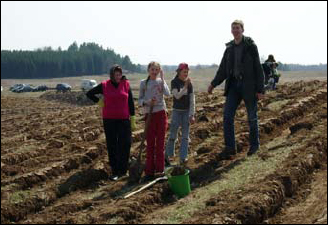 |
A. Gaižutis |
Lithuania’s total forest area is 2.1 million hectares, or 33.5 percent of the land area (FAO, 2006). National forest inventory statistics indicate that forest condition is improving and forest area and wood resources are increasing. Enhanced sustainable development of the forest sector could lead to fuller realization of the social, environmental and economic values and functions of forests.
The total volume of growing stock in the forests of Lithuania is 400 million cubic metres (FAO, 2006). The average forest area per capita is 0.6 ha, and the average volume of growing stock per capita is 199 m³ accordingly. Current annual increment in Lithuanian forests is over 13.1 million cubic metres, and current annual increment per hectare is 6.5 m³ (State Forest Survey Service of Lithuania, 2007).
Prior to 1920, 65 percent of Lithuania’s forest was privately owned. Under land reform in the 1920s, nationalization of part of the land reduced the share of privately owned forest to 32 percent. When the Soviets annexed Lithuania in 1940, they nationalized all private properties, including forest, until 100 percent of the forest was State owned.
The State now owns about half the forest area. As of 1 April 2007, private forests accounted for 35 percent of total forests (770 000 ha), and 14 percent of forest area was reserved for restitution (300 000 ha) (State Forest Survey Service of Lithuania, 2007).
About 460 000 people have presented applications to have their property rights restored and some 40 000 to buy land and/or forest. The aggregate demand on all land for privatization is 3.73 million hectares. Moreover, some 500 000 ha of marginal agricultural land (mostly privately owned) is expected to be afforested in the future by the State and private forest owners. This process has already started; the plans are to establish some 200 000 ha of new forest by 2020 (Ministry of Agriculture of Lithuania, 2002). By 1 April 2007, Lithuania had 232 000 private forest owners (State Forest Survey Service of Lithuania, 2007). The total number of private forest holdings is 149 000, as family-owned forest holdings are usually held jointly with co-owners. Company ownership of forest land is new and accounts for several thousand hectares. For instance, Bangenes Miskas Ltd owns 3 000 ha, while several other companies have forest landholdings in the range of 1 000 to 2 000 ha.
Since the accession of Lithuania to the European Union on 1 May 2004, any company registered in the country has been able to purchase forest. Citizens of other countries are not yet allowed to own forest and agricultural land in Lithuania; after accession to the EU a seven-year transition period was foreseen before foreigners could purchase land/forest.
It is expected that after completion of the restitution process approximately 45 to 47 percent of Lithuania’s forest land, or more than 900 000 ha, will be in private hands (including companies) (Gaizutis, 2005).
A forest day organized by a local forest owners’ association in Kaunas District – a popular event among family forest owners |
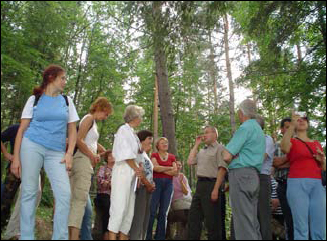 |
I. Kudarauskiene |
During recent years roundwood supplies from private forests have consistently increased (Figure 1). Private forests currently account for some 3 million cubic metres per year, i.e. 40 to 47 percent of total roundwood supply. Final felling constitutes a significant part of the removals (Figure 2). In both State and private forest, harvesting is carried out almost entirely by private contractor companies. Nearly 53 percent of roundwood is still sold by State forest enterprises (Figure 3).
The forests reserved for restitution represent an additional potential of 1.5 million cubic metres of wood annually, currently protected by felling restrictions because of unclear ownership.
| 1 Roundwood supply in Lithuania, 1990–2006 |
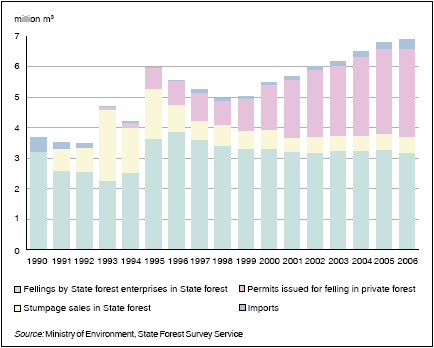 |
| 2 Removals from Lithuania’s private forest holdings by felling type |
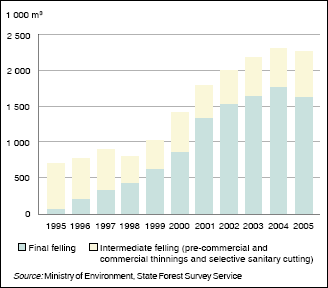 |
| 3 Main actors in the roundwood market of Lithuania |
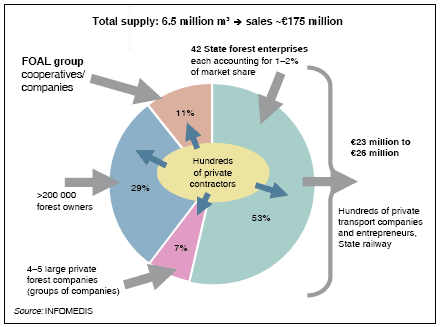 |
Forestry has only a small or even a negligible role in the household economy of many family forest owners in Lithuania. Because of the small, fragmented holdings, forest management is complicated and relatively expensive. The problem is magnified because many forest owners have limited or no knowledge about forest management and usually live far from their property. Nevertheless citizens of Lithuania prefer to regain their forest property rights rather than apply for the low compensation offered by the State, which is in the range of €300 to €400 per hectare. In contrast, the market price of premature and mature stands (standing timber plus forest land) in commercial coniferous forest can vary from €7 000 to more than €15 000 per hectare, so forest owners have the potential to earn money. The forest is also an important source of fuelwood supply for many households.
The Forest Owners’ Association of Lithuania, the national public organization that represents and unites private forest owners, is helping to develop management structures for private forestry. Established in 1993, FOAL now has more than 5 500 active members. It also works with non-members through 38 regional associations.
FOAL has supported the development of a network of forest owners’ cooperatives and collaborating companies. The first owners’ cooperative was founded in 1998, and within a short time others were created as the industrial demand for roundwood and owners’ demand for forestry services rapidly increased (Gaizutis, 2005). The network currently comprises 25 to 30 small companies and cooperatives, and it continues to expand rapidly. These companies employ over 130 skilled professional foresters offering forest owners the full range of forest management and marketing services under the FOAL umbrella. However, the demand for services still exceeds current capabilities.
The network operates on two levels. In the field, cooperatives advise local forest owners and consolidate production volumes. These are then marketed through roundwood trading companies that specialize in supplying the largest buyers.
In 2001, FOAL created the market information system “Infomedis” (meaning “info tree”) (see www.forest.lt/index.php?1123976489), a monthly bulletin supplying up-to-date market information on roundwood sales and prices in private forests, distributed by electronic mailing.
Members of forest owners’ cooperatives have established a marketing company, Ekomediena Ltd (see www.ekomediena.it), to centralize wood trade with the main domestic and foreign clients, which has operated successfully since October 2002. Other forestry and forest industry groups have also joined the FOAL network – for example the wood panel and furniture production holding company Vakaru Medienos Grupe (VMG) and Bangene, the largest Lithuanian capital-based trading company, which exports roundwood (pulpwood and logs) mainly to Poland, the Russian Federation, Germany and Sweden.
Although the volumes supplied by each of the FOAL cooperatives and companies are small, nearly 70 to 80 percent of their roundwood is sold through specialized wood trading companies that belong to the network, which now supplies 20 000 to 25 000 m3 of roundwood monthly. Being a large supplier, such a network is able to guarantee stability and favourable conditions for both buyers of roundwood and producers – family forest owners.
The volume of roundwood marketed through the FOAL network has increased from only 30 000 m3 in 2001 to 650 000 m3 by 2006 – i.e. by 2 166 percent (Figure 4). At the same time total roundwood supply from private forests in Lithuania has increased by only 35 to 40 percent. Thus the companies under the FOAL umbrella have captured the additional market share; in 2006 they sold 26 percent of roundwood from private forest (compared with only 2 percent in 2001) and 10 percent of total Lithuanian roundwood supply. FOAL has been the largest roundwood supplier in Lithuania since 2004.
Forest owners can participate in the network in a number of different ways. They can be full members of a cooperative; they can sign a long-term forest management agreement; they can sell standing timber (or a whole forest) through the network; or they can simply purchase forestry services.
FOAL has become the largest roundwood supplier in Lithuania because the better bargaining power at the large scale enables it to achieve sales prices that are about 10 percent higher than the market average. These benefits are then passed back to the forest owner. Before the cooperative movement took off, roundwood from private forests sold for 20 percent less than the market average.
The outlook for the FOAL network is very positive. It has credibility with the largest buyers in the market. It is also looking at future alliances, cooperation and vertical integration to lead to further benefits that can be passed on to the small-scale forest owners who are members of the cooperatives.
| Forest owners’ cooperatives have purchased modern wood transportation equipment to guarantee stability of wood deliveries |
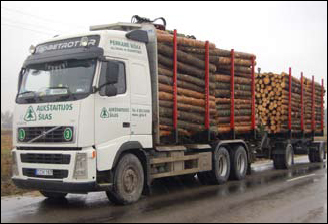 |
Cooperative Aukstaitijos Silas |
| 4 Roundwood sales by companies under the FOAL umbrella |
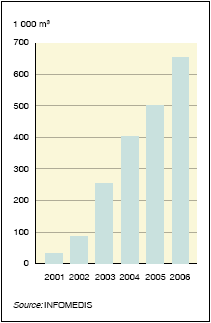 |
![]() Bibliography
Bibliography
FAO. 2006. Global Forest Resources Assessment 2005 – progress towards sustainable forest management. FAO Forestry Paper No. 147. Rome. Available at: www.fao.org/docrep/008/a0400e/a0400e00.htm
Gaižutis, A. 2005. Gaining a position for small-scale private forestry trough creation of marketing system for wood trade: case of Lithuania. In S. Mizaras, ed. Small-scale forestry in a changing environment, p. 130–136. Proceedings of an international symposium, IUFRO Research Group 3.08.00, Vilnius, Lithuania, 30 May – 4 June 2005. Kaunas, Lithuania, Lithuanian Forest Research Institute.
Ministry of Agriculture of Lithuania. 2002. The programme of afforestation of Lithuania for 2004–2020. Available online: www3.lrs.lt/pls/inter3/dokpaieska.showdoc_l?p_id=198062 [In Lithuanian]
State Forest Survey Service of Lithuania. 2007. Private forest statistics. Kaunas, Lithuania, Ministry of Environment. Available online: www.lvmi.lt/vmt [In Lithuanian]